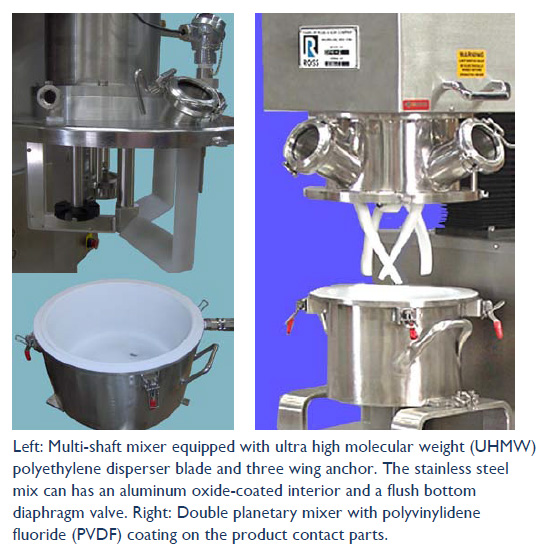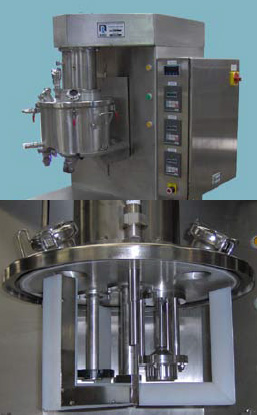Tech Report
Mixing abrasive pastes and slurries

Technology Brief
Dispersion of abrasive solids into liquid can be accomplished in single-shaft, multi-shaft or planetary mixers, depending on product rheology and degree of abrasion. This bulletin discusses some strategies for combating abrasive wear in these types of mixers.
Dispersing abrasive solids
Abrasive pastes and slurries are two-phase systems or dispersions of abrasive solid particles within a liquid vehicle. Creating a uniform and stable dispersion requires a balance of adequate mixing and an acceptable rate of wear. Geometry, hardness and size are considered to be the most important properties of abrasive particles which directly affect wear rate. The mixing mechanism also has a bearing since high velocity and energy impact can accelerate wear and erosion.
Mixer choices and strategies for combating abrasive wear
Abrasive effects can be minimized by selecting the appropriate agitation system, operating at relatively low speeds and applying surface treatment.
Rheology and degree of abrasion are the main considerations in mixer selection. If the viscosities of the starting liquid and final slurry are relatively low (>50,000cP), moderately abrasive slurries can be processed in a single-shaft mixer. For example, a high speed disperser equipped with an ultra high molecular weight (UHMW) polyethylene blade can achieve fast wet-out and dispersion of abrasive solids. Compared to stainless steel, the standard material of construction of most mixers, UHMW polyethylene is more resistant to wear and lasts longer. The polyethylene blade is usually symmetrical and can be turned over to further extend its use and performance.
With moderate to high viscosity products, single-shaft mixers are incapable of producing adequate material turnover on their own and are thus often used in combination with an anchor agitator. The low speed anchor agitator promotes bulk flow in a multi-shaft mixer and can be made out of a variety of abrasion-resistant metals. This depends on the specific application though because apart from wear issues, certain products cannot tolerate any metal contamination for reasons related to purity, discoloration, corrosion, electrical performance, etc.
As viscosity rises, even a multi-shaft mixer arrangement will eventually fail to produce sufficient flow. A shift to planetary mixing must be considered at this point. A double planetary mixer (DPM) moves batch material by rotating two identical blades on their own axes as they orbit a common axis. The mixer`s comparatively low speed but very thorough agitation lends it suitable for the application of abrasion-resistant coatings. For this reason, the DPM is a popular choice for highly abrasive slurries, including those in the low viscosity range. In contrast, hardfacing a disperser or rotor/stator is not recommended because the coating may chip off due to the high operating speeds.
Some of the most commonly used coatings are aluminum oxide, chromium oxide, polyvinylidene fluoride (PVDF), nylon and tungsten carbide. Other surface treatments include electropolishing, boronizing and hard chrome plating.
Aside from the agitators and vessel surfaces, the mixer`s discharge valve arrangement must also be designed appropriately. High-performance diaphragm, slide gate and plug valves are generally ideal for abrasive applications.
Sample Application: Abrasive Encapsulation Material

This Ross VersaMix Multi-Shaft Mixer is equipped with a disperser blade and anchor agitator made of UHMW polyethylene. It also has a rotor/stator assembly with electropolished surfaces. The mix vessel`s aluminum oxide-coated interior is ground to a 20 Ra finish.
There are no scrapers attached to the anchor agitator as abrasive particles can imbed in them and cause aggressive wear on the vessel surfaces. Scrapers can also cause unnecessary stress on the agitator due to excessive friction.